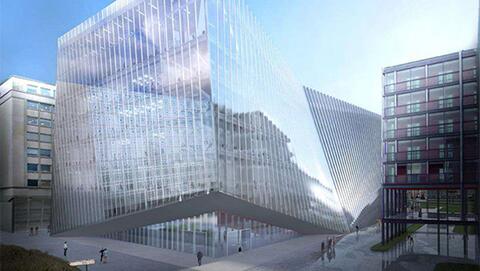
Stéphane Labbé: "The Sorbonne University Cité de l'Innovation will offer a unique environment for developing new ideas."
As the Sorbonne University Cité de l'Innovation project takes shape, Stéphane Labbé, director of SUMMIT — Sorbonne University's House of Modeling, Engineering and Technologies — reveals the behind-the-scenes of this initiative set to transform the innovation landscape.
Can you tell us about SUMMIT's role within the Sorbonne University Cité de l'Innovation?
Stéphane Labbé :
As a service unit, SUMMIT will continue playing the same role it has had since January 2021: serving as a bridge between the research world and the socio-economic world. Within the Sorbonne University Cité de l'Innovation, we’ll carry this mission forward in an even more integrated setting. We act as translators, converting the language of research into terms understandable to businesses — and vice versa. With the help of engineers from our three technical departments, we also assist researchers in bringing their ideas to life.
The Cité will give us the framework to strengthen synergies between all the actors of innovation.
Who are the other key players in the Sorbonne University Cité de l'Innovation?
S. L. : The other key actors are SATT Lutech, Agoranov, and Pépite — all of whom we already collaborate with closely. The technology transfer acceleration company (SATT) supports startups. The Agoranov incubator — which helped launch companies like Doctolib — provides office space, staff, resources, and investor connections. The national Pépite program offers students support to develop their innovative ideas. One of the big challenges will be to coordinate all these interactions and ensure that every player finds their place.
What will be SUMMIT's specific contribution within this ecosystem?
S. L. : To understand our contribution, it helps to look at the Technology Readiness Level (TRL) scale, which measures how mature a technology is — from early-stage ideas (levels 1 to 4), to prototypes (levels 5 to 7), all the way to production (levels 8 to 9). We mainly operate at the beginning of this scale.
We help researchers transform their ideas into viable concepts by offering technical consulting and engineering services. We support them in developing prototypes — though we don’t go all the way to final products.
Can you give us a few examples of projects you’ve supported?
S. L. : There are many. Recently, we manufactured 200 swarm robots for the Pogobot project, in partnership with the university’s fablab. They have large-scale equipment, and we provided the smaller tools for the final touches. In a completely different area, we developed an algorithm for Eau de Paris to monitor its water network and detect leaks using very limited data.
We’ve also worked with students on innovative projects like an underwater walkie-talkie and a music-learning method based on neuroscience, developed by a pianist and researcher. And there are many more examples available on our website.
How will SUMMIT interact with companies within the Sorbonne University Cité de l'Innovation?
S. L. : Startups and small to mid-sized companies will be located in the on-site business hotel, where they’ll benefit from direct access to all four main actors of the Cité. Our role will be to offer them both technical and conceptual support. We’ll also continue working closely with IT service companies to help them with both commercial and technical development aspects.
What kinds of events do you plan to organize within the Cité?
S. L. : The Cité brings all the key players together in one place — making it much easier to collaborate, share ideas, and build momentum. A large space on the building’s ground floor will be dedicated to fostering internal connections and external visibility.
In line with the university’s broader goals, we aim to spark real energy and curiosity from the business world. We want them to see and understand our work — and to be eager to keep collaborating with us. Businesses and startups on-site will be able to come and view our work directly.
In this context, we’ll organize events that bring together the entire ecosystem: trade fairs, networking meetups, thematic seminars, and training sessions tailored to the needs of companies, students, and researchers.
How do you see the future of the Sorbonne University Cité de l'Innovation?
S. L. :
The Cité will transform the innovation landscape by facilitating collaboration among researchers, companies, and students. It will provide a unique environment for developing new ideas and launching startups — reinforcing our entire innovation ecosystem.
It’s meant to be an open, inclusive space — one that shares and spreads a culture of innovation throughout the university community and with our external partners. This initiative aligns with the university’s strategic priorities, particularly as part of the Sorbonne University Alliance’s University Innovation Cluster.
We hope this initiative will attract new talent and foster an open, collaborative culture of innovation.
